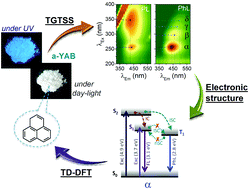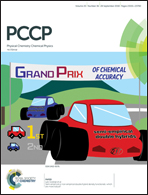Time-gated triplet-state optical spectroscopy to decipher organic luminophores embedded in rigid matrices†
Abstract
Wet-chemically synthesized inorganic materials often exhibit luminescence behavior. We have recently shown that the amorphous yttrium-aluminium-borate (a-YAB) powders obtained by sol–gel and modified Pechini methods exhibit organic impurities, responsible for their intense visible photoluminescence and phosphorescence afterglow. However, the heterogeneity of impurity organic compounds and difficulties in their intact extraction from the solid inorganic host matrix limit the extraction-based chemical analysis for luminophore identification. Here, we propose a photo-physical route based on time-gated triplet-state optical spectroscopy (TGTSS) to construct the electronic structures of the trapped unknown luminophores, which successfully illustrates the luminescence properties of a-YAB powders in more detail and also provides important insights intrinsic to the nature of the luminophores. The experimental results accompanied with TD-DFT calculations of the theoretical electronic structures thus help us to propose the probable luminophore compounds trapped in rigid a-YAB matrices. We anticipate that the present approach will open new opportunities for analyzing similar complex luminescent materials, including carbon dots, graphene oxides, etc., which is vital for their improvement.

- This article is part of the themed collection: 2018 PCCP HOT Articles


 Please wait while we load your content...
Please wait while we load your content...